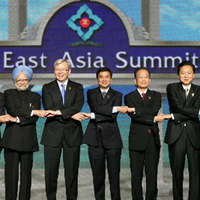East Asia in a 'World of Regions'
East Asia has achieved one of the most profound economic transformations in recorded history. In 1960, the region accounted for only 4 percent of world gross domestic product, but by the 1990s, it had become one of three core economic regions -- along with Europe and North America -- that together dominated the global economy. East Asia has become the new workshop of the world, the location of fast-emerging markets, and a new financial power in the making. The region now accounts for slightly more than a quarter of world trade, production, new technology patents and gross domestic product, and is home to some of the world's largest banks and multinational enterprises.
In short, East Asia has become an essential part of the new regional order -- a "world of regions," or an international system increasingly defined by interactions between regions and regional powers. East Asia's advance owes much to its economic regionalization, initially spearheaded by Japan and more recently by China. Globalization, too, has been a key driver of East Asia's regional integration, perhaps most clearly revealed by its regional production networks that serve both global markets and global production networks.

